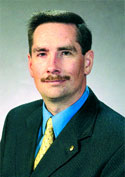
Features
Codes and standards
Hot topics
NFPA Impact: New objective-based codes have failed the service
The newly released National Building and Fire Codes of Canada do not identify the protection of emergency responders as a core requirement. In fact, nowhere – even in the new functional statements – is this an identified requirement. This will create major problems in the future should the fire service wish to initiate changes to the code using this rationale.
December 11, 2007
By Sean Tracey
 The newly released National Building and Fire Codes of Canada do not identify the protection of emergency responders as a core requirement. In fact, nowhere – even in the new functional statements – is this an identified requirement. This will create major problems in the future should the fire service wish to initiate changes to the code using this rationale. A concerted effort by emergency responders’ associations at the national and provincial level is needed to correct this serious flaw. The best way is to select a member to represent them on these committees.
The newly released National Building and Fire Codes of Canada do not identify the protection of emergency responders as a core requirement. In fact, nowhere – even in the new functional statements – is this an identified requirement. This will create major problems in the future should the fire service wish to initiate changes to the code using this rationale. A concerted effort by emergency responders’ associations at the national and provincial level is needed to correct this serious flaw. The best way is to select a member to represent them on these committees.
In 1996 a task group convened by the National Research Council confirmed that “the scope of the National Fire Code covered the life safety of both the normal occupants of buildings as well as emergency response personnel, in particular fire fighters, present during a fire or explosion.”1 Yet, when the first round of public discussions came out regarding the objectives and functional statements of the new “objective-based” National Fire Code, this was excluded from core requirements and the functional statements. When the first round of public consultation was conducted, this lack of identification of the need to protect first responders was raised but summarily rejected. I was told informally that it was dismissed, stating that it was too late to go back! The NFPA1 Uniform Fire Code and NFPA 5000 Building Construction and Safety Code, for comparison, has the protection of first responders as a stated objective.2 The fire service should push now for the correction of this oversight.
Why was the fire service marginalized in this process? I believe it is because there is no national representation of their needs. The Canadian Commission on Building and Fire Codes (CCBFC) oversees the national model code development process in Canada. Based on the last publicized list of members, there is no one representing a provincial fire chief’s or fire service association. Of the 28 members only two are representative of the fire service (two provincial fire marshals). The unfortunate sudden death of Doug Lion has created a further void on the council. Of the remaining members, nine are building officials, nine are special interest groups and seven are architects and engineers.
The Standing Committee for Fire Safety and Occupancy that develops NBC Part 3 Fire Protection, Occupant Safety, and Accessibility and the NFC has only one serving fire service person.3 Yet there are five building officials – individuals who do not normally even enforce the Fire Code. Compare this with approximately 25 per cent representation by the fire service on the NFPA 1 Uniform Fire Code.
The fire service needs to get engaged in these committees or you will continue to have a completed document passed to you for enforcement that does not protect you in your profession.
How is this a problem? Without having a core objective of first responder safety, no new submission to the code can use this as a rational to support code modifications. Remember one of the other tasks recently completed in the code was a bottom-up analysis to link every code provision to the core objectives. Those code items having no basis would be removed. Similarly, no new code provisions will be accepted unless they can be linked to a core requirement. NFPA codes have identified first responder safety as a core requirement and therefore the NFPA 1 Uniform Fire Code has much better provisions to address emergency responder needs. These include the requirement for building placards to identify hazards for emergency responders, the marking of shaftways, provisions for access boxes, and other safety systems in buildings that consider how fire fighters respond in emergencies.
The code provisions appear in the NFPA Fire Code because of past fire fighter fatalities and near misses, and because the fire service has representation in the NFPA process. Without the addition of a requirement to protect emergency responders, future fire service code change submissions will simply be rejected in the Canadian codes.
The newly released National Fire Code has failed emergency responders. By not recognizing that there is a need to protect them, and consider their tasks, they are placed at an increased risk. National and provincial associations need to get engaged now, take up membership on these committees, and initiate the changes needed so that the next edition in 2010 will be more suitable.
1 www.nationalcodes.ca/nfc/archives/task_groups/scope/docs/ meeting_1_e.shtml .
2 NFPA 1/UFC 4.1.3.1.1.(2), NFPA 5000 4.1.3.1.1.(2) state: “Buildings shall be designed and constructed to provide reasonable safety for fire fighters and emergency responders during search and rescue operations.” There is no similar provision in the NFC or NBC.
3 As per the NRC website www.nationalcodes.ca/ccbfc/comm/fso_memberlist_e.shtml last updated 2002-10-04.W
Sean Tracey, P.Eng., is the Canadian regional manager of NFPA International and formerly the Canadian Armed Forces Fire Marshal. He may be reached at 613-830-9102, e-mail stracey@nfpa.org .
Print this page